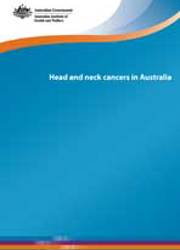Summary
Head and neck cancer is a term used to describe a range of cancers that occur in the throat (pharynx and larynx), nose, sinuses and mouth.
This report presents the most recent data available on head and neck cancer incidence, mortality, survival and hospitalisations and also describes risk factors that can contribute to a person developing head and neck cancer.
The report also includes a 'spotlight' section which discusses the human papillomavirus (HPV) and how it contributes to head and neck cancers.
Incidence
The number of head and neck cancers diagnosed in Australia is increasing. From 1982 to 2009, the number of head and neck cancers diagnosed rose from 2,475 to 3,896.
While the number of cases diagnosed is rising, the age-standardised incidence rate for head and neck cancers fell from 19.3 per 100,000 persons in 1982 to 16.8 per 100,000 in 2009. Increases in the overall number of cases diagnosed are occurring, despite decreases in age-standardised incidence rates, because of Australia's increasing and ageing population.
The number of cases diagnosed in 2009 was higher for males than females. Males accounted for 73.8% (2,875) of head and neck cancers compared to 26.2% (1,021) for females.
Mortality
Similar to the number of cases diagnosed, the number of deaths from head and neck cancers rose from 752 in 1982 to 944 in 2011.
The age-standardised mortality rate fell from 6.1 per 100,000 persons in 1982 to 3.8 per 100,000 in 2011. Increases in the overall number of deaths due to head and neck cancers are occurring, despite a drop in the age-standardised mortality rates, because of the growth and ageing of Australia's population.
Males accounted for a higher number of deaths in 2011 than females, with 73.2% (691) of deaths from head and neck cancers among males compared to 26.8% (253) for females.
Survival
Overall survival from head and neck cancers is improving. There was a rise in 5-year relative survival from 61.8% in 1982-1987 to 68.2% in 2006-2010. One-year relative survival for males and females in 2006-2010 were broadly comparable. However, 5-year relative survival for females was higher at 70.4% compared to males at 67.4%.
Hospitalisations
Hositalisations for head and neck cancers are also rising. In 2011-12, there were 8,478 hospitalisations where head and neck cancer was the principal diagnosis. This was an increase of 13.8% from 2002-03 when there were 7,448 hospitalisations.
The number of hospitalisations for surgery where head and neck cancer was the principal diagnosis also increased over time, from 3,305 in 2002-03 to 3,725 in 2011-12. This was an overall increase of 12.7%.
Preliminary material: Acknowledgments; Abbreviations
Introduction
Facts about head and neck cancers
Incidence of head and neck cancers
- Incidence of head and neck cancers combined
- Incidence of head and neck cancer groups
- Incidence rates of head and neck cancer groups
Mortality from head and neck cancers
- Number of deaths from head and neck cancers combined
- Number of deaths in head and neck cancer groups
- Mortality rates for head and neck cancer groups
Survival from head and neck cancers
- Survival for head and neck cancers combined
- Survival for head and neck cancer groups
Hospitalisations for head and neck cancers
- Hospitalisations for head and neck cancers combined
- Hospitalisations for head and neck cancer groups
- Number of hospitalisations involving surgery
- Chemotherapy and radiotherapy for head and neck cancers
- Hospitalisation rates for head and neck cancer groups
- Surgery rates for head and neck cancers
- Chemotherapy and radiotherapy rates for head and neck cancers
Spotlight on the human papillomavirus and head and neck cancer
- What is human papilloma virus?
- HPV and head and neck cancer
- HPV and the Australian National Immunisation Program
Discussion
Appendix A
Appendix B
End matter: Tables; Glossary; References; List of figures; List of tables; Related publications



